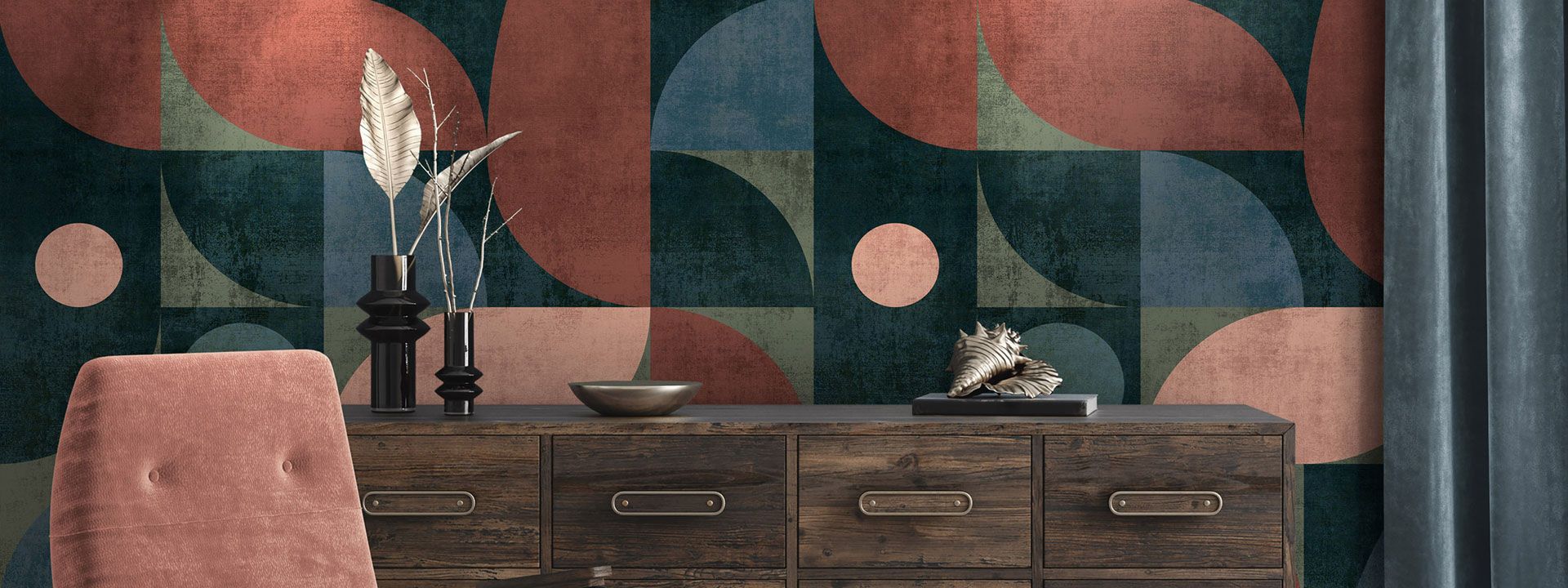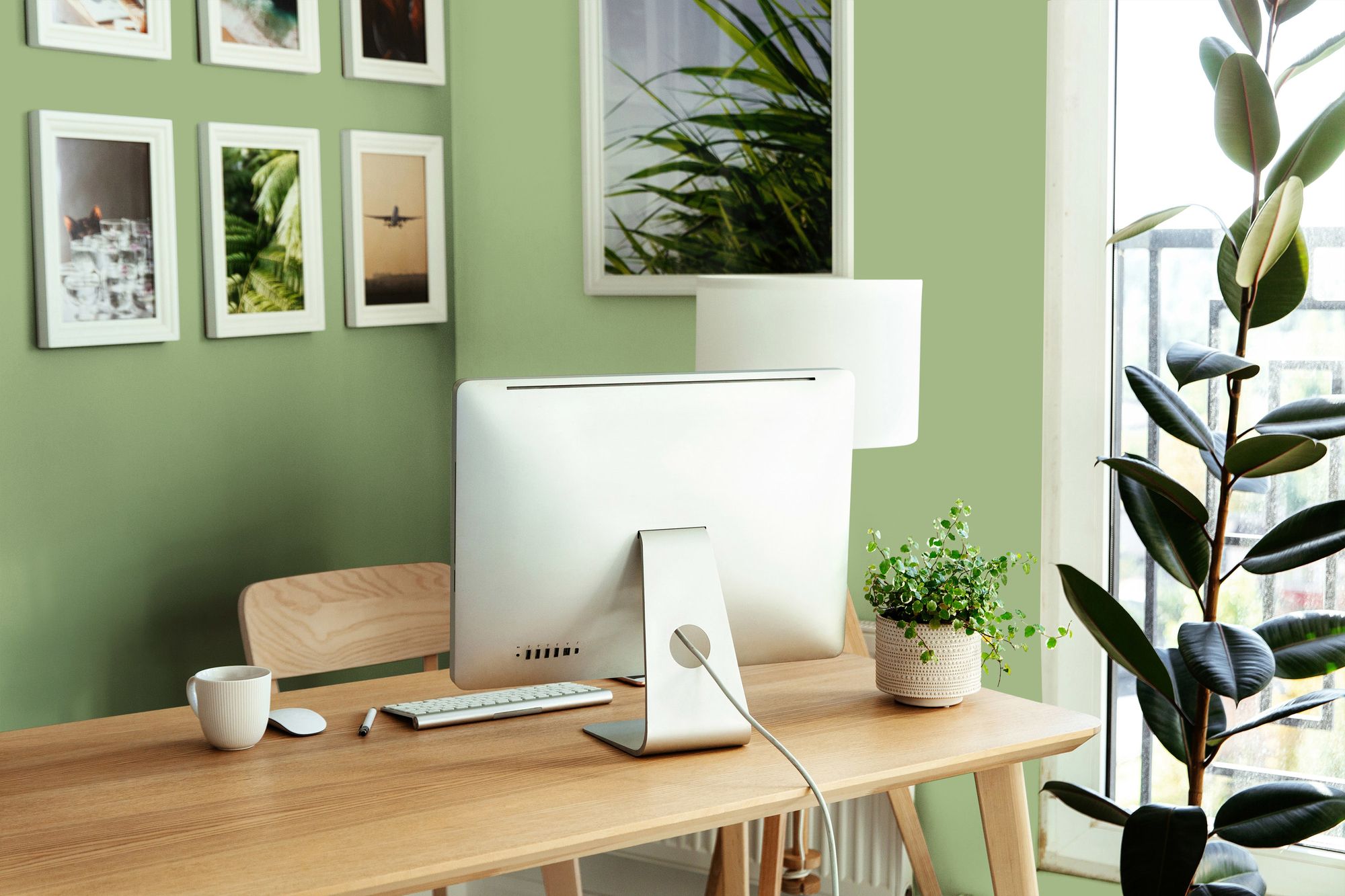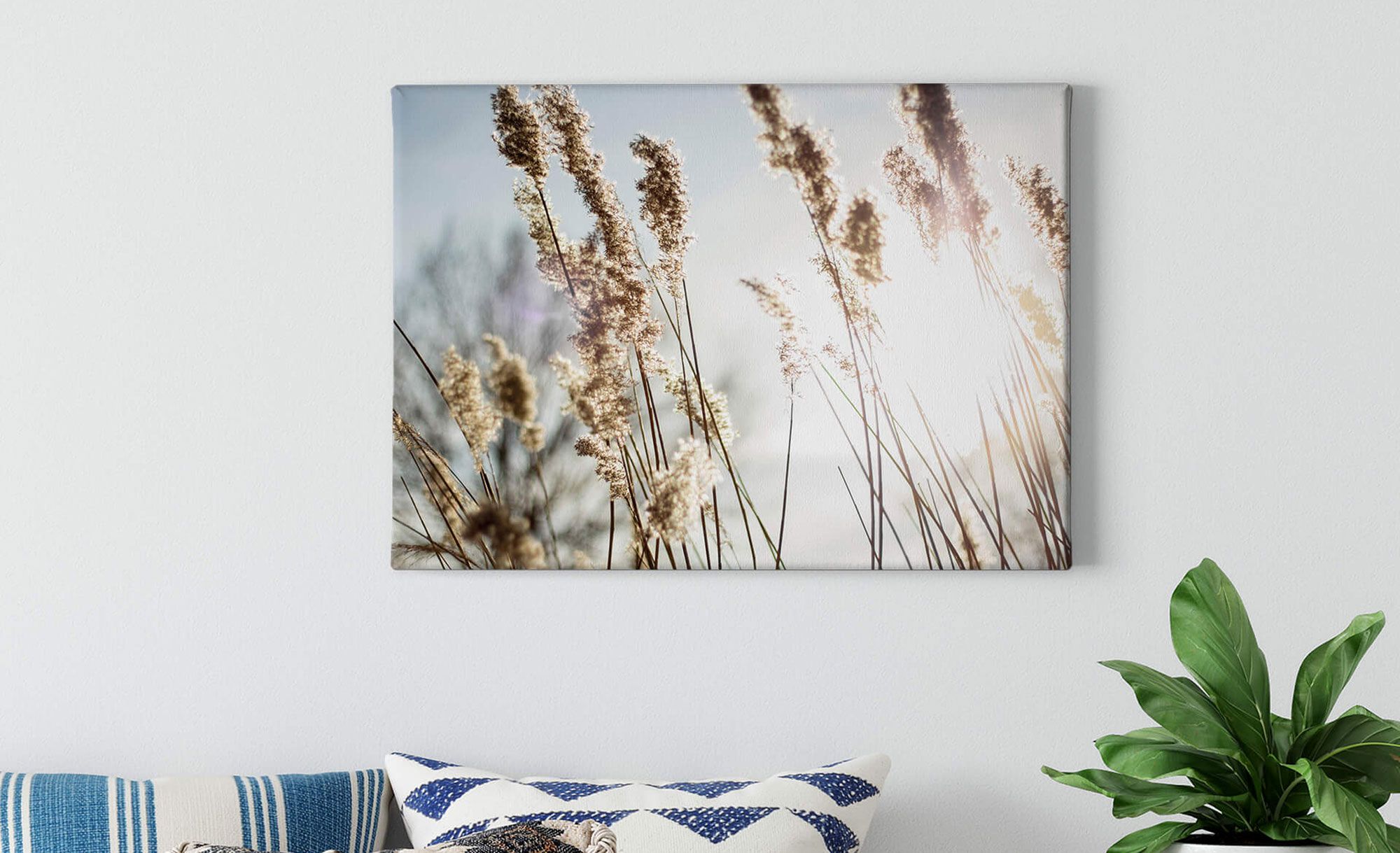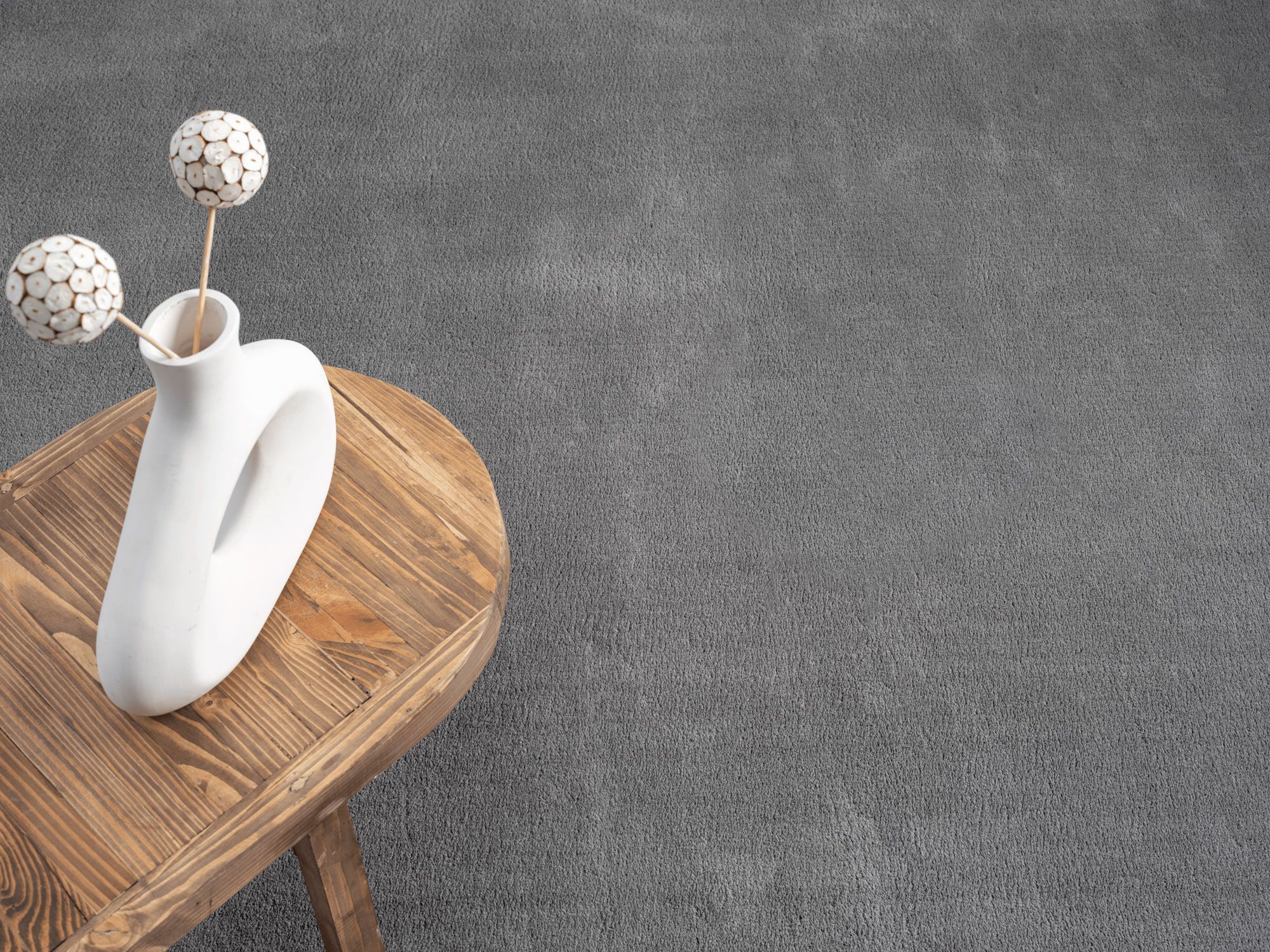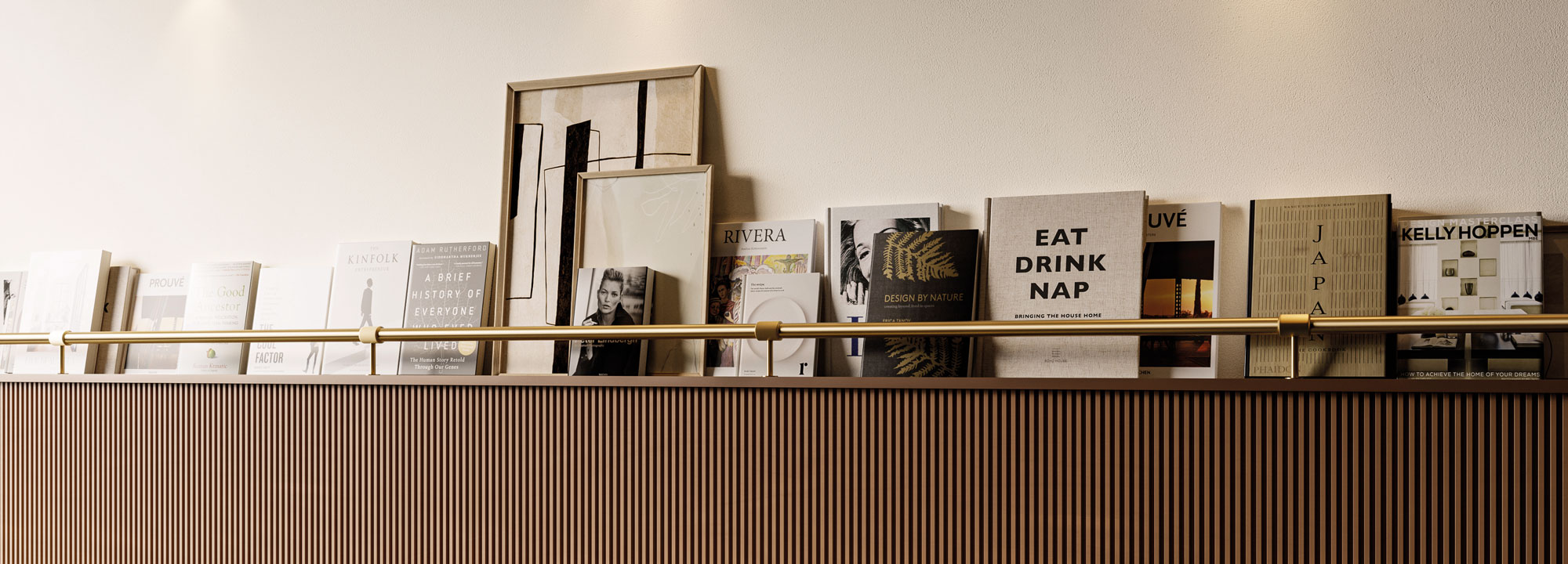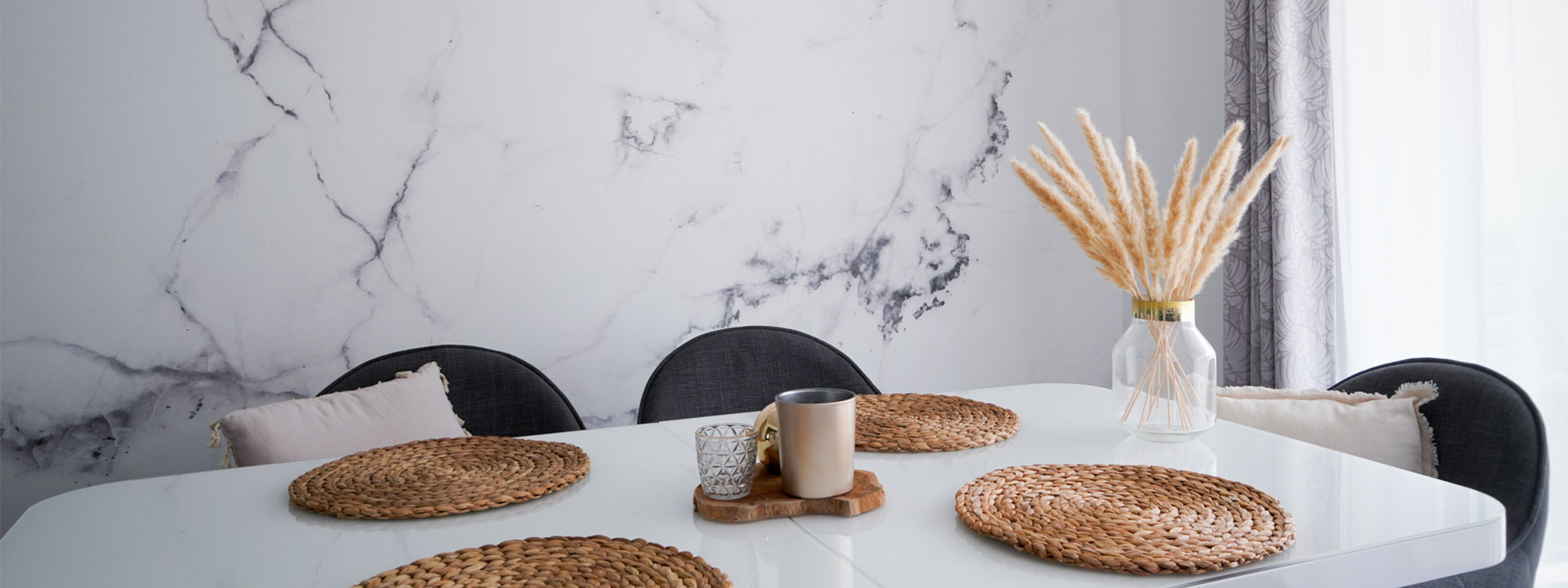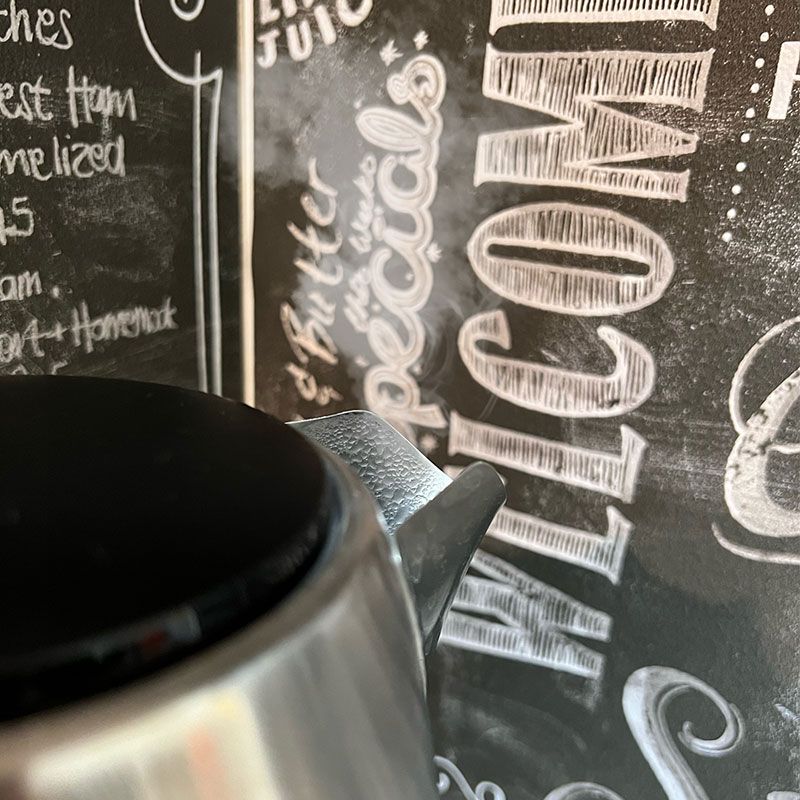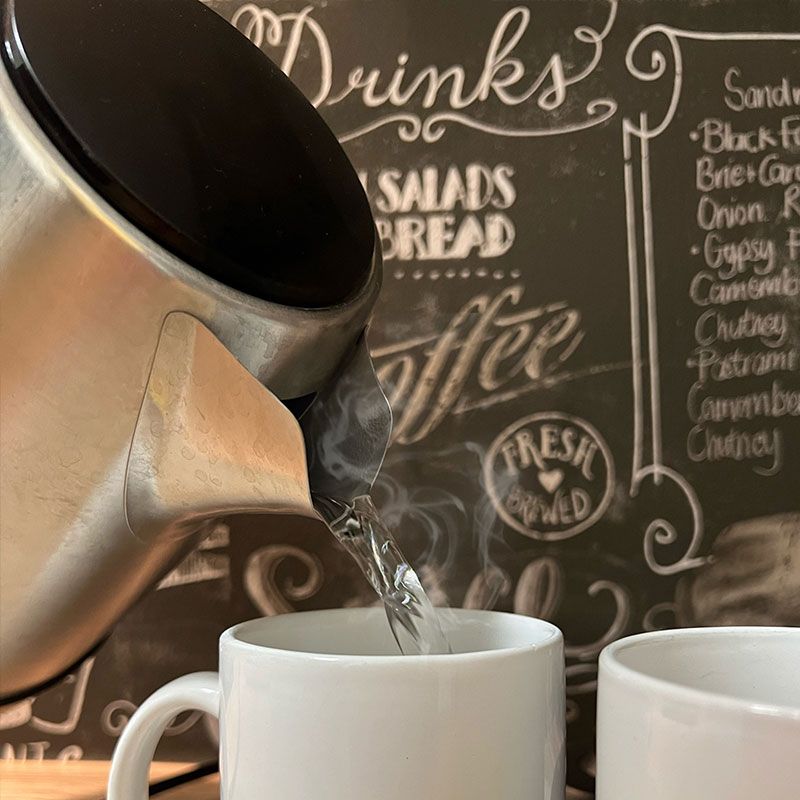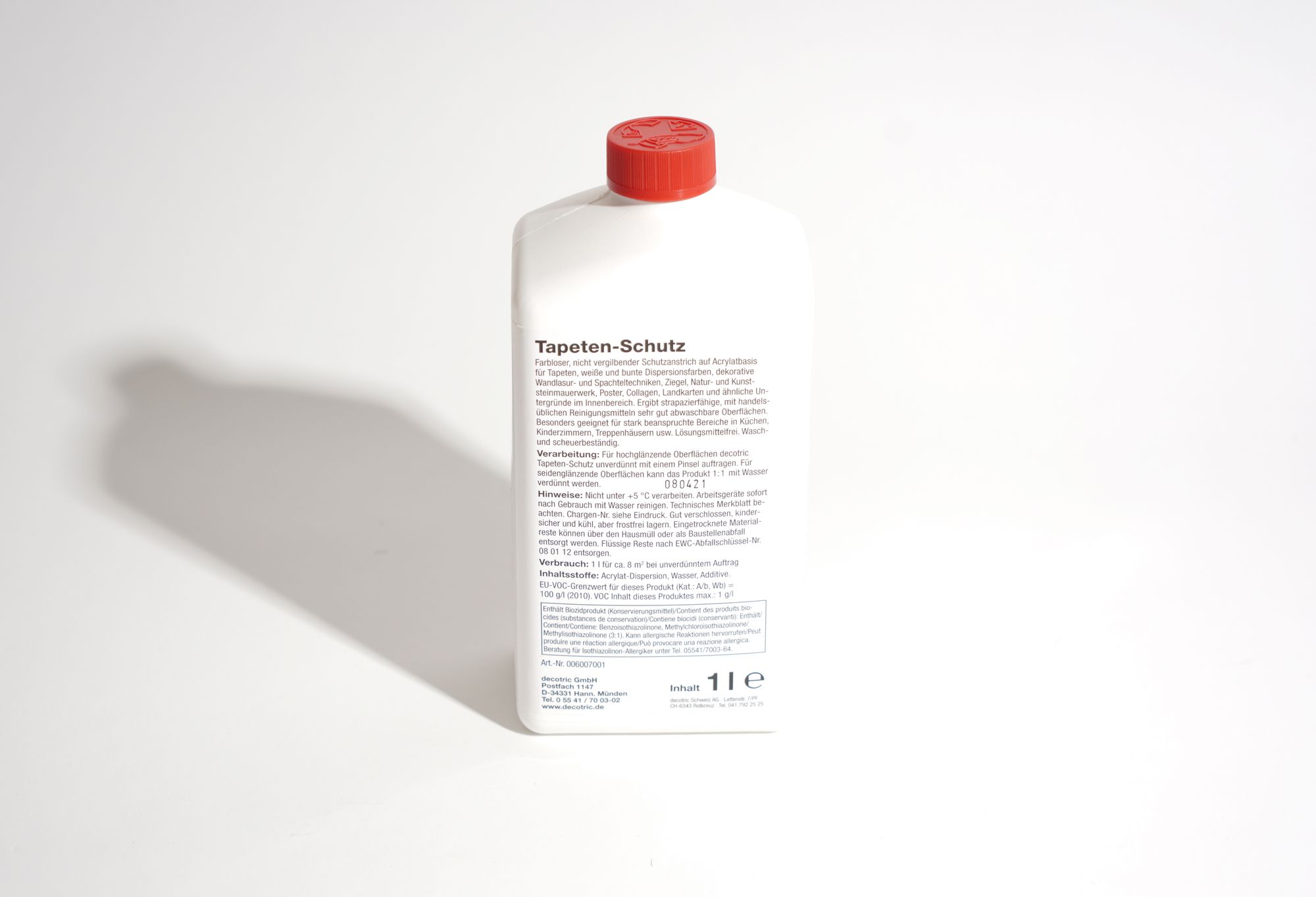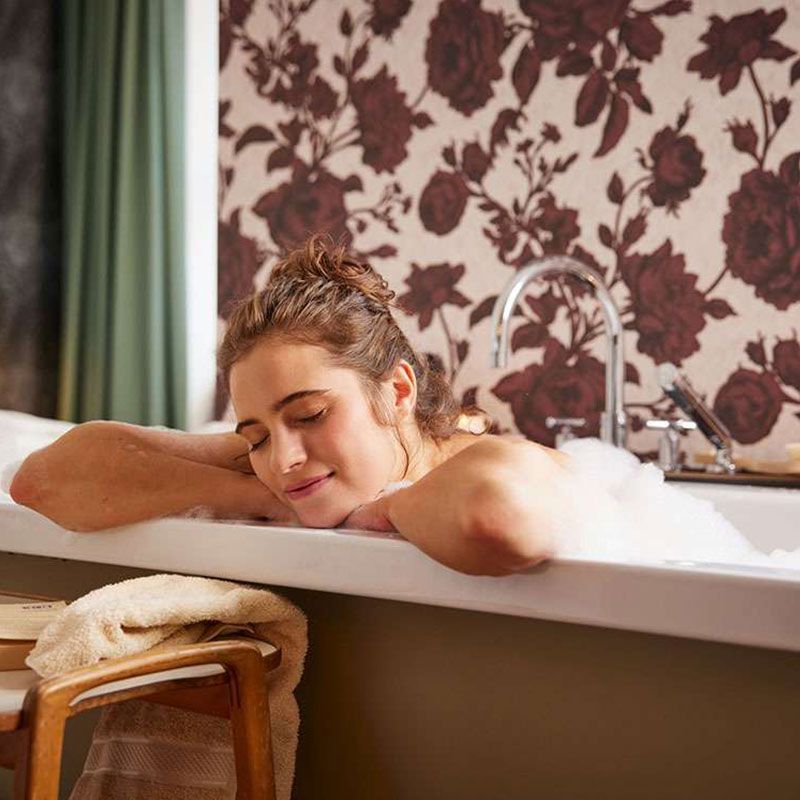Wallpaper: Water resistance, washing resistance and abrasion resistance
What should you do if your wallpaper has become dirty? The simple answer is: you should clean it! Here you will find out exactly what you need to pay attention to and which wallpapers you can clean, and how. We will explain which wallpaper types can be cleaned to remove soiling, dirt and dust. We’ll also give you tips on how to care for your wallpaper correctly, as well as the important wallpaper symbols for cleaning wallpaper.
The essentials in a nutshell:
It’s not equally easy to remove dirt effectively from all wallpapers; the key to this is the type of wallpaper and the wallpaper surface. Paper wallpapers are particularly sensitive and can only be cleaned to a limited extent; non-woven wallpapers and vinyl wallpapers vary in how resistant they are, and they can only be cleaned using the correct technique. On the other hand, sealed fibreglass wallpapers can almost always be restored to their original state of cleanliness. Ordinary dirt or stains can be removed with water and a cleaning product depending on the washing resistance of the wallpaper. The wallpaper symbol reveals how resistant the wallpaper is. Use our overview to quickly find out how resistant your wallpaper is and how you should go about cleaning it.
Water resitant:
The wallpaper can withstand moisture and splashes of water, it remains dimensionally stable at low levels of humidity and does not warp. Wallpapers labelled in this way can be cleaned of dirt with care and a damp cloth only. It’s important not to soak the wallpaper through or to attempt to remove the dirt by washing or rubbing. We recommend tapping lightly with a damp, lint-free cloth. Water resistant wallpapers often contain natural fibres such as paper or wood; they are sensitive to moisture. You should initially try to wipe away surface dirt when dry. Heavy soiling can only be removed with patience and care. Discolouration can often not be completely removed, only minimised.
Care & Cleaning Tip
If the wallpaper is likely to be frequently exposed to splashes of water or soiling, we recommend additionally sealing the wall with a transparent coating to protect the wallpaper. So-called ‘elephant hide’ protects the wallpaper and is easy to wipe down.
Washable:
Washable wallpapers bear the double-wave symbol; as the name suggests, they are not only dimensionally stable or water resistant, it is also easier to remove dirt from them. You can wipe down a wallpaper bearing this label with a damp (not wet) sponge. You should also avoid rubbing and wiping the wallpaper as much as possible. You can easily clean the textured surface with a soft sponge. Use clear water which is no warmer than lukewarm, and do not use cleaning products containing solvents.
Care & Cleaning Tip
If the wallpaper is heavily soiled or discoloured, you can add a drop of detergent to the water. The water should not be foaming; you can remove splashes of grease with a mild detergent.
Extra washable:
Soiling can be removed from the wallpaper. Using a soft sponge and mild soapy water, you can wipe down the wallpaper, using only a little pressure, and dry the wallpaper with a lint-free cloth. Oil and grease can be partially removed, and discolourations can be minimised. By using a little pressure only and using patting motions, you can clean the wallpaper exactly where it is needed. Extra washable wallpapers are also suitable for use in the kitchen and the bathroom, as splashes of water don’t affect them. The surface texture plays a particular role with this type of wallpaper; embossed and smooth wallpapers are easier to clean than three-dimensional foam textures. Foam surfaces are not as compact or susceptible to abrasion, so you should only use a little pressure and no wiping motions.
Care & Cleaning Tip
Test the cleaning of the wallpaper on a remnant or in an inconspicuous place. In this way, you can tell which cleaning products are mild enough and don’t damage the wallpaper. Always remove splashes such as grease or oil stains immediately to avoid discolourations.
Abrasion resistant:
Water, a mild soapy solution and a soft brush are the right tools for cleaning an abrasion resistant wallpaper. These resilient wallpapers have a firm texture and a wipeable surface made from non-woven material and/or vinyl. Cooking splashes and road grime are easy to remove from wallpapers of this kind. Light, circular movements are effective and provide a good result. If the wallpaper is dusty or yellowed, the surface can also be cleaned with a damp, lint-free cloth. That makes them particularly suitable for high-traffic rooms, for example, in living rooms, kitchens or bathrooms.
Care & Cleaning Tip
For even greater resistance against stains, these abrasion resistant wallpapers can also be sealed with a transparent artificial resin. You can purchase a liquid wallpaper protection product, which can be painted over the wallpaper like a transparent film and which is also wipeable.
Extra abrasion resistant:
These wallpapers are the most abrasion resistant, resisting all forms of soiling. They are ideal for kitchens or bathrooms, as even high humidity and regular splashes of water do not affect these wallpapers. Using a soft brush, a microfibre cloth and soapy water, you can wipe down and clean the wallpapered wall. A damp cloth is ideal for remove soiling – by wiping the wallpaper down lightly and using targeted patting motions, you will be able to remove almost all stains without a trace. Extra abrasion resistant wallpapers are generally also long-lasting and resilient, which is why they are often used in public buildings or shops. Vinyl wallpapers or wallpapers coated in artificial resin are not only decorative, they are also high performance.
Care & Cleaning Tip
The wallpapers can be cleaned with simple agents, but solvent-based cleaning agents are not suitable even for extra abrasion resistant wallpapers. Work with a damp cloth or sponge and detergents dissolved in water. Dirt erasers and cleaning agents should first be tested on a remnant of wallpaper or on an inconspicuous spot on the wall.
Water resitant:
The wallpaper can withstand moisture and splashes of water, it remains dimensionally stable at low levels of humidity and does not warp. Wallpapers labelled in this way can be cleaned of dirt with care and a damp cloth only. It’s important not to soak the wallpaper through or to attempt to remove the dirt by washing or rubbing. We recommend tapping lightly with a damp, lint-free cloth. Water resistant wallpapers often contain natural fibres such as paper or wood; they are sensitive to moisture. You should initially try to wipe away surface dirt when dry. Heavy soiling can only be removed with patience and care. Discolouration can often not be completely removed, only minimised.
Care & Cleaning Tip
If the wallpaper is likely to be frequently exposed to splashes of water or soiling, we recommend additionally sealing the wall with a transparent coating to protect the wallpaper. So-called ‘elephant hide’ protects the wallpaper and is easy to wipe down.
Washable:
Washable wallpapers bear the double-wave symbol; as the name suggests, they are not only dimensionally stable or water resistant, it is also easier to remove dirt from them. You can wipe down a wallpaper bearing this label with a damp (not wet) sponge. You should also avoid rubbing and wiping the wallpaper as much as possible. You can easily clean the textured surface with a soft sponge. Use clear water which is no warmer than lukewarm, and do not use cleaning products containing solvents.
Care & Cleaning Tip
If the wallpaper is heavily soiled or discoloured, you can add a drop of detergent to the water. The water should not be foaming; you can remove splashes of grease with a mild detergent.
Extra washable:
Soiling can be removed from the wallpaper. Using a soft sponge and mild soapy water, you can wipe down the wallpaper, using only a little pressure, and dry the wallpaper with a lint-free cloth. Oil and grease can be partially removed, and discolourations can be minimised. By using a little pressure only and using patting motions, you can clean the wallpaper exactly where it is needed. Extra washable wallpapers are also suitable for use in the kitchen and the bathroom, as splashes of water don’t affect them. The surface texture plays a particular role with this type of wallpaper; embossed and smooth wallpapers are easier to clean than three-dimensional foam textures. Foam surfaces are not as compact or susceptible to abrasion, so you should only use a little pressure and no wiping motions.
Care & Cleaning Tip
Test the cleaning of the wallpaper on a remnant or in an inconspicuous place. In this way, you can tell which cleaning products are mild enough and don’t damage the wallpaper. Always remove splashes such as grease or oil stains immediately to avoid discolourations.
Abrasion resistant:
Water, a mild soapy solution and a soft brush are the right tools for cleaning an abrasion resistant wallpaper. These resilient wallpapers have a firm texture and a wipeable surface made from non-woven material and/or vinyl. Cooking splashes and road grime are easy to remove from wallpapers of this kind. Light, circular movements are effective and provide a good result. If the wallpaper is dusty or yellowed, the surface can also be cleaned with a damp, lint-free cloth. That makes them particularly suitable for high-traffic rooms, for example, in living rooms, kitchens or bathrooms.
Care & Cleaning Tip
For even greater resistance against stains, these abrasion resistant wallpapers can also be sealed with a transparent artificial resin. You can purchase a liquid wallpaper protection product, which can be painted over the wallpaper like a transparent film and which is also wipeable.
Extra abrasion resistant:
These wallpapers are the most abrasion resistant, resisting all forms of soiling. They are ideal for kitchens or bathrooms, as even high humidity and regular splashes of water do not affect these wallpapers. Using a soft brush, a microfibre cloth and soapy water, you can wipe down and clean the wallpapered wall. A damp cloth is ideal for remove soiling – by wiping the wallpaper down lightly and using targeted patting motions, you will be able to remove almost all stains without a trace. Extra abrasion resistant wallpapers are generally also long-lasting and resilient, which is why they are often used in public buildings or shops. Vinyl wallpapers or wallpapers coated in artificial resin are not only decorative, they are also high performance.
Care & Cleaning Tip
The wallpapers can be cleaned with simple agents, but solvent-based cleaning agents are not suitable even for extra abrasion resistant wallpapers. Work with a damp cloth or sponge and detergents dissolved in water. Dirt erasers and cleaning agents should first be tested on a remnant of wallpaper or on an inconspicuous spot on the wall.
Water resitant:
The wallpaper can withstand moisture and splashes of water, it remains dimensionally stable at low levels of humidity and does not warp. Wallpapers labelled in this way can be cleaned of dirt with care and a damp cloth only. It’s important not to soak the wallpaper through or to attempt to remove the dirt by washing or rubbing. We recommend tapping lightly with a damp, lint-free cloth. Water resistant wallpapers often contain natural fibres such as paper or wood; they are sensitive to moisture. You should initially try to wipe away surface dirt when dry. Heavy soiling can only be removed with patience and care. Discolouration can often not be completely removed, only minimised.
Care & Cleaning Tip
If the wallpaper is likely to be frequently exposed to splashes of water or soiling, we recommend additionally sealing the wall with a transparent coating to protect the wallpaper. So-called ‘elephant hide’ protects the wallpaper and is easy to wipe down.
Washable:
Washable wallpapers bear the double-wave symbol; as the name suggests, they are not only dimensionally stable or water resistant, it is also easier to remove dirt from them. You can wipe down a wallpaper bearing this label with a damp (not wet) sponge. You should also avoid rubbing and wiping the wallpaper as much as possible. You can easily clean the textured surface with a soft sponge. Use clear water which is no warmer than lukewarm, and do not use cleaning products containing solvents.
Care & Cleaning Tip
If the wallpaper is heavily soiled or discoloured, you can add a drop of detergent to the water. The water should not be foaming; you can remove splashes of grease with a mild detergent.
Extra washable:
Soiling can be removed from the wallpaper. Using a soft sponge and mild soapy water, you can wipe down the wallpaper, using only a little pressure, and dry the wallpaper with a lint-free cloth. Oil and grease can be partially removed, and discolourations can be minimised. By using a little pressure only and using patting motions, you can clean the wallpaper exactly where it is needed. Extra washable wallpapers are also suitable for use in the kitchen and the bathroom, as splashes of water don’t affect them. The surface texture plays a particular role with this type of wallpaper; embossed and smooth wallpapers are easier to clean than three-dimensional foam textures. Foam surfaces are not as compact or susceptible to abrasion, so you should only use a little pressure and no wiping motions.
Care & Cleaning Tip
Test the cleaning of the wallpaper on a remnant or in an inconspicuous place. In this way, you can tell which cleaning products are mild enough and don’t damage the wallpaper. Always remove splashes such as grease or oil stains immediately to avoid discolourations.
Abrasion resistant:
Water, a mild soapy solution and a soft brush are the right tools for cleaning an abrasion resistant wallpaper. These resilient wallpapers have a firm texture and a wipeable surface made from non-woven material and/or vinyl. Cooking splashes and road grime are easy to remove from wallpapers of this kind. Light, circular movements are effective and provide a good result. If the wallpaper is dusty or yellowed, the surface can also be cleaned with a damp, lint-free cloth. That makes them particularly suitable for high-traffic rooms, for example, in living rooms, kitchens or bathrooms.
Care & Cleaning Tip
For even greater resistance against stains, these abrasion resistant wallpapers can also be sealed with a transparent artificial resin. You can purchase a liquid wallpaper protection product, which can be painted over the wallpaper like a transparent film and which is also wipeable.
Extra abrasion resistant:
These wallpapers are the most abrasion resistant, resisting all forms of soiling. They are ideal for kitchens or bathrooms, as even high humidity and regular splashes of water do not affect these wallpapers. Using a soft brush, a microfibre cloth and soapy water, you can wipe down and clean the wallpapered wall. A damp cloth is ideal for remove soiling – by wiping the wallpaper down lightly and using targeted patting motions, you will be able to remove almost all stains without a trace. Extra abrasion resistant wallpapers are generally also long-lasting and resilient, which is why they are often used in public buildings or shops. Vinyl wallpapers or wallpapers coated in artificial resin are not only decorative, they are also high performance.
Care & Cleaning Tip
The wallpapers can be cleaned with simple agents, but solvent-based cleaning agents are not suitable even for extra abrasion resistant wallpapers. Work with a damp cloth or sponge and detergents dissolved in water. Dirt erasers and cleaning agents should first be tested on a remnant of wallpaper or on an inconspicuous spot on the wall.
Water resitant:
The wallpaper can withstand moisture and splashes of water, it remains dimensionally stable at low levels of humidity and does not warp. Wallpapers labelled in this way can be cleaned of dirt with care and a damp cloth only. It’s important not to soak the wallpaper through or to attempt to remove the dirt by washing or rubbing. We recommend tapping lightly with a damp, lint-free cloth. Water resistant wallpapers often contain natural fibres such as paper or wood; they are sensitive to moisture. You should initially try to wipe away surface dirt when dry. Heavy soiling can only be removed with patience and care. Discolouration can often not be completely removed, only minimised.
Care & Cleaning Tip
If the wallpaper is likely to be frequently exposed to splashes of water or soiling, we recommend additionally sealing the wall with a transparent coating to protect the wallpaper. So-called ‘elephant hide’ protects the wallpaper and is easy to wipe down.
Washable:
Washable wallpapers bear the double-wave symbol; as the name suggests, they are not only dimensionally stable or water resistant, it is also easier to remove dirt from them. You can wipe down a wallpaper bearing this label with a damp (not wet) sponge. You should also avoid rubbing and wiping the wallpaper as much as possible. You can easily clean the textured surface with a soft sponge. Use clear water which is no warmer than lukewarm, and do not use cleaning products containing solvents.
Care & Cleaning Tip
If the wallpaper is heavily soiled or discoloured, you can add a drop of detergent to the water. The water should not be foaming; you can remove splashes of grease with a mild detergent.
Extra washable:
Soiling can be removed from the wallpaper. Using a soft sponge and mild soapy water, you can wipe down the wallpaper, using only a little pressure, and dry the wallpaper with a lint-free cloth. Oil and grease can be partially removed, and discolourations can be minimised. By using a little pressure only and using patting motions, you can clean the wallpaper exactly where it is needed. Extra washable wallpapers are also suitable for use in the kitchen and the bathroom, as splashes of water don’t affect them. The surface texture plays a particular role with this type of wallpaper; embossed and smooth wallpapers are easier to clean than three-dimensional foam textures. Foam surfaces are not as compact or susceptible to abrasion, so you should only use a little pressure and no wiping motions.
Care & Cleaning Tip
Test the cleaning of the wallpaper on a remnant or in an inconspicuous place. In this way, you can tell which cleaning products are mild enough and don’t damage the wallpaper. Always remove splashes such as grease or oil stains immediately to avoid discolourations.
Abrasion resistant:
Water, a mild soapy solution and a soft brush are the right tools for cleaning an abrasion resistant wallpaper. These resilient wallpapers have a firm texture and a wipeable surface made from non-woven material and/or vinyl. Cooking splashes and road grime are easy to remove from wallpapers of this kind. Light, circular movements are effective and provide a good result. If the wallpaper is dusty or yellowed, the surface can also be cleaned with a damp, lint-free cloth. That makes them particularly suitable for high-traffic rooms, for example, in living rooms, kitchens or bathrooms.
Care & Cleaning Tip
For even greater resistance against stains, these abrasion resistant wallpapers can also be sealed with a transparent artificial resin. You can purchase a liquid wallpaper protection product, which can be painted over the wallpaper like a transparent film and which is also wipeable.
Extra abrasion resistant:
These wallpapers are the most abrasion resistant, resisting all forms of soiling. They are ideal for kitchens or bathrooms, as even high humidity and regular splashes of water do not affect these wallpapers. Using a soft brush, a microfibre cloth and soapy water, you can wipe down and clean the wallpapered wall. A damp cloth is ideal for remove soiling – by wiping the wallpaper down lightly and using targeted patting motions, you will be able to remove almost all stains without a trace. Extra abrasion resistant wallpapers are generally also long-lasting and resilient, which is why they are often used in public buildings or shops. Vinyl wallpapers or wallpapers coated in artificial resin are not only decorative, they are also high performance.
Care & Cleaning Tip
The wallpapers can be cleaned with simple agents, but solvent-based cleaning agents are not suitable even for extra abrasion resistant wallpapers. Work with a damp cloth or sponge and detergents dissolved in water. Dirt erasers and cleaning agents should first be tested on a remnant of wallpaper or on an inconspicuous spot on the wall.
Water resitant:
The wallpaper can withstand moisture and splashes of water, it remains dimensionally stable at low levels of humidity and does not warp. Wallpapers labelled in this way can be cleaned of dirt with care and a damp cloth only. It’s important not to soak the wallpaper through or to attempt to remove the dirt by washing or rubbing. We recommend tapping lightly with a damp, lint-free cloth. Water resistant wallpapers often contain natural fibres such as paper or wood; they are sensitive to moisture. You should initially try to wipe away surface dirt when dry. Heavy soiling can only be removed with patience and care. Discolouration can often not be completely removed, only minimised.
Care & Cleaning Tip
If the wallpaper is likely to be frequently exposed to splashes of water or soiling, we recommend additionally sealing the wall with a transparent coating to protect the wallpaper. So-called ‘elephant hide’ protects the wallpaper and is easy to wipe down.
Washable:
Washable wallpapers bear the double-wave symbol; as the name suggests, they are not only dimensionally stable or water resistant, it is also easier to remove dirt from them. You can wipe down a wallpaper bearing this label with a damp (not wet) sponge. You should also avoid rubbing and wiping the wallpaper as much as possible. You can easily clean the textured surface with a soft sponge. Use clear water which is no warmer than lukewarm, and do not use cleaning products containing solvents.
Care & Cleaning Tip
If the wallpaper is heavily soiled or discoloured, you can add a drop of detergent to the water. The water should not be foaming; you can remove splashes of grease with a mild detergent.
Extra washable:
Soiling can be removed from the wallpaper. Using a soft sponge and mild soapy water, you can wipe down the wallpaper, using only a little pressure, and dry the wallpaper with a lint-free cloth. Oil and grease can be partially removed, and discolourations can be minimised. By using a little pressure only and using patting motions, you can clean the wallpaper exactly where it is needed. Extra washable wallpapers are also suitable for use in the kitchen and the bathroom, as splashes of water don’t affect them. The surface texture plays a particular role with this type of wallpaper; embossed and smooth wallpapers are easier to clean than three-dimensional foam textures. Foam surfaces are not as compact or susceptible to abrasion, so you should only use a little pressure and no wiping motions.
Care & Cleaning Tip
Test the cleaning of the wallpaper on a remnant or in an inconspicuous place. In this way, you can tell which cleaning products are mild enough and don’t damage the wallpaper. Always remove splashes such as grease or oil stains immediately to avoid discolourations.
Abrasion resistant:
Water, a mild soapy solution and a soft brush are the right tools for cleaning an abrasion resistant wallpaper. These resilient wallpapers have a firm texture and a wipeable surface made from non-woven material and/or vinyl. Cooking splashes and road grime are easy to remove from wallpapers of this kind. Light, circular movements are effective and provide a good result. If the wallpaper is dusty or yellowed, the surface can also be cleaned with a damp, lint-free cloth. That makes them particularly suitable for high-traffic rooms, for example, in living rooms, kitchens or bathrooms.
Care & Cleaning Tip
For even greater resistance against stains, these abrasion resistant wallpapers can also be sealed with a transparent artificial resin. You can purchase a liquid wallpaper protection product, which can be painted over the wallpaper like a transparent film and which is also wipeable.
Extra abrasion resistant:
These wallpapers are the most abrasion resistant, resisting all forms of soiling. They are ideal for kitchens or bathrooms, as even high humidity and regular splashes of water do not affect these wallpapers. Using a soft brush, a microfibre cloth and soapy water, you can wipe down and clean the wallpapered wall. A damp cloth is ideal for remove soiling – by wiping the wallpaper down lightly and using targeted patting motions, you will be able to remove almost all stains without a trace. Extra abrasion resistant wallpapers are generally also long-lasting and resilient, which is why they are often used in public buildings or shops. Vinyl wallpapers or wallpapers coated in artificial resin are not only decorative, they are also high performance.
Care & Cleaning Tip
The wallpapers can be cleaned with simple agents, but solvent-based cleaning agents are not suitable even for extra abrasion resistant wallpapers. Work with a damp cloth or sponge and detergents dissolved in water. Dirt erasers and cleaning agents should first be tested on a remnant of wallpaper or on an inconspicuous spot on the wall.
Water resitant:
The wallpaper can withstand moisture and splashes of water, it remains dimensionally stable at low levels of humidity and does not warp. Wallpapers labelled in this way can be cleaned of dirt with care and a damp cloth only. It’s important not to soak the wallpaper through or to attempt to remove the dirt by washing or rubbing. We recommend tapping lightly with a damp, lint-free cloth. Water resistant wallpapers often contain natural fibres such as paper or wood; they are sensitive to moisture. You should initially try to wipe away surface dirt when dry. Heavy soiling can only be removed with patience and care. Discolouration can often not be completely removed, only minimised.
Care & Cleaning Tip
If the wallpaper is likely to be frequently exposed to splashes of water or soiling, we recommend additionally sealing the wall with a transparent coating to protect the wallpaper. So-called ‘elephant hide’ protects the wallpaper and is easy to wipe down.
Washable:
Washable wallpapers bear the double-wave symbol; as the name suggests, they are not only dimensionally stable or water resistant, it is also easier to remove dirt from them. You can wipe down a wallpaper bearing this label with a damp (not wet) sponge. You should also avoid rubbing and wiping the wallpaper as much as possible. You can easily clean the textured surface with a soft sponge. Use clear water which is no warmer than lukewarm, and do not use cleaning products containing solvents.
Care & Cleaning Tip
If the wallpaper is heavily soiled or discoloured, you can add a drop of detergent to the water. The water should not be foaming; you can remove splashes of grease with a mild detergent.
Extra washable:
Soiling can be removed from the wallpaper. Using a soft sponge and mild soapy water, you can wipe down the wallpaper, using only a little pressure, and dry the wallpaper with a lint-free cloth. Oil and grease can be partially removed, and discolourations can be minimised. By using a little pressure only and using patting motions, you can clean the wallpaper exactly where it is needed. Extra washable wallpapers are also suitable for use in the kitchen and the bathroom, as splashes of water don’t affect them. The surface texture plays a particular role with this type of wallpaper; embossed and smooth wallpapers are easier to clean than three-dimensional foam textures. Foam surfaces are not as compact or susceptible to abrasion, so you should only use a little pressure and no wiping motions.
Care & Cleaning Tip
Test the cleaning of the wallpaper on a remnant or in an inconspicuous place. In this way, you can tell which cleaning products are mild enough and don’t damage the wallpaper. Always remove splashes such as grease or oil stains immediately to avoid discolourations.
Abrasion resistant:
Water, a mild soapy solution and a soft brush are the right tools for cleaning an abrasion resistant wallpaper. These resilient wallpapers have a firm texture and a wipeable surface made from non-woven material and/or vinyl. Cooking splashes and road grime are easy to remove from wallpapers of this kind. Light, circular movements are effective and provide a good result. If the wallpaper is dusty or yellowed, the surface can also be cleaned with a damp, lint-free cloth. That makes them particularly suitable for high-traffic rooms, for example, in living rooms, kitchens or bathrooms.
Care & Cleaning Tip
For even greater resistance against stains, these abrasion resistant wallpapers can also be sealed with a transparent artificial resin. You can purchase a liquid wallpaper protection product, which can be painted over the wallpaper like a transparent film and which is also wipeable.
Extra abrasion resistant:
These wallpapers are the most abrasion resistant, resisting all forms of soiling. They are ideal for kitchens or bathrooms, as even high humidity and regular splashes of water do not affect these wallpapers. Using a soft brush, a microfibre cloth and soapy water, you can wipe down and clean the wallpapered wall. A damp cloth is ideal for remove soiling – by wiping the wallpaper down lightly and using targeted patting motions, you will be able to remove almost all stains without a trace. Extra abrasion resistant wallpapers are generally also long-lasting and resilient, which is why they are often used in public buildings or shops. Vinyl wallpapers or wallpapers coated in artificial resin are not only decorative, they are also high performance.
Care & Cleaning Tip
The wallpapers can be cleaned with simple agents, but solvent-based cleaning agents are not suitable even for extra abrasion resistant wallpapers. Work with a damp cloth or sponge and detergents dissolved in water. Dirt erasers and cleaning agents should first be tested on a remnant of wallpaper or on an inconspicuous spot on the wall.
Washing resistance & abrasion resistance of fibreglass wallpapers
Fibreglass wallpapers are a true powerhouse; these woven wall hangings are not only particularly stable and robust, but in combination with a sealed coating, they are practically indestructible and extremely resilient. This is also demonstrated through the washing resistance and the cleaning options for the wallpaper. By applying a coat of emulsion paint or latex paint, this creates a sealed wall surface that can be wiped and cleaned. Fibreglass wallpaper has many characteristics which make it a popular choice for wall decoration – you can find out more on our advice page for fibreglass fabric.
Water stains, grease stains and other stains on the wall
Unfortunately, there isn’t one single method that will remove all stains from any wallpaper. But don’t worry – almost all stains can be treated and removed. For optimal cleaning, you should always know what type of dirt it is and which type of wallpaper you are working with. Stains and dirt can usually be assigned to a single source, splashes of grease in the kitchen, water marks in the bathroom, dirt from the street in the hall or crayon marks in the children’s rooms. If you know where a stain comes from, you can also say which cleaning product will dissolve it and make it disappear; splashes of water need to dry out, oil and grease can be dissolved with a mild washing up liquid, crayon marks can be rubbed out with an eraser, etc. Using the classification distinguishing between washable and abrasion resistant wallpapers, you can learn which cleaning methods and products are recommended. With the help of the wallpaper symbols, you can see at a glance to what extent the material is washable or abrasion resistant.
But sometimes you don’t know exactly what type of dirt or wallpaper you have, for example, when you are doing a renovation project. In this case, you need to proceed with caution, because if you don’t know how the wallpaper will react, you can cause even more damage by cleaning the product; and in the worst-case scenario, you might have to remove the wallpaper and re-wallpaper the wall. In situations like this, it makes sense to pick an inconspicuous spot where you can carefully test which materials and techniques will bring you a successful result.
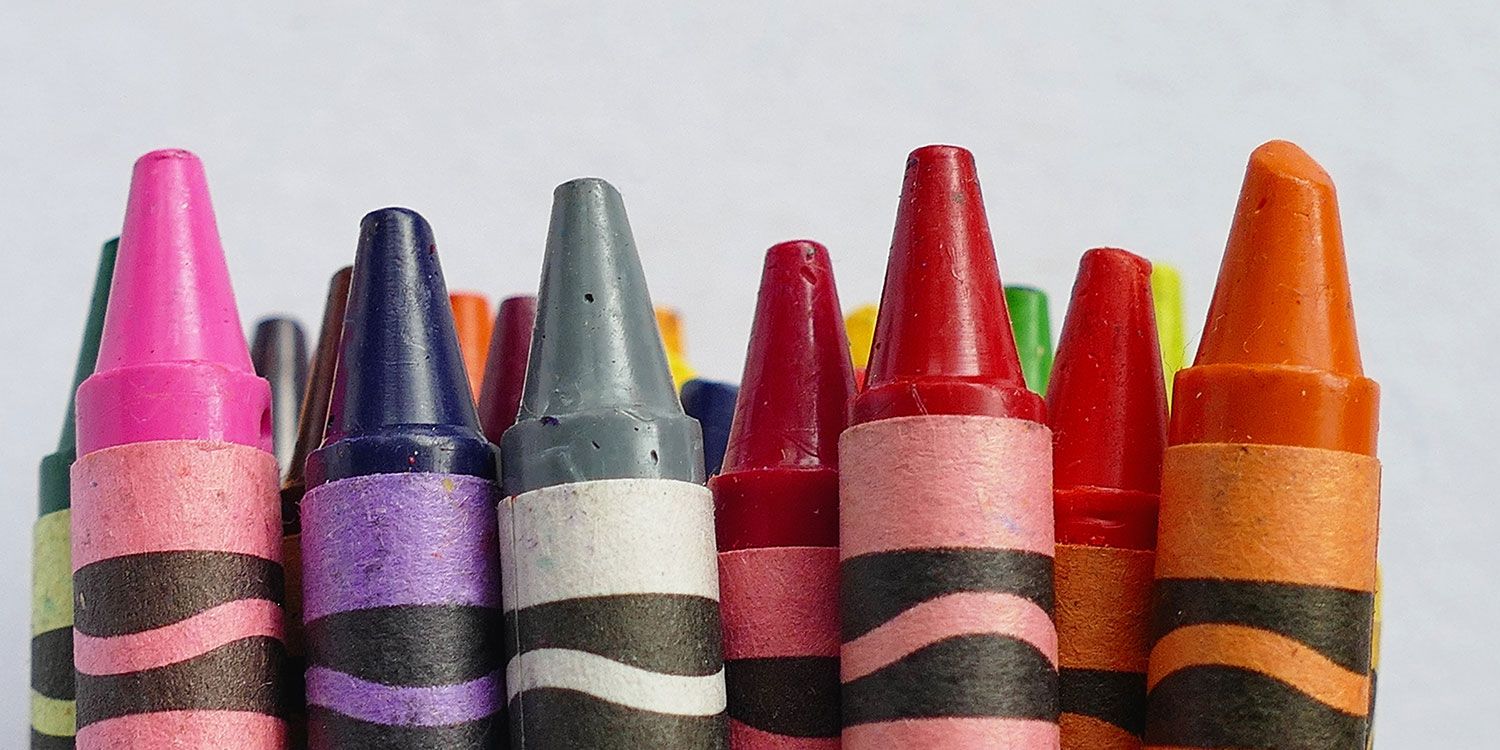
Cleaning the wallpaper
The internet is full of tips and tricks, recommendations and household hacks for cleaning wallpaper. Acquaintances and friends have also often experienced this and are happy to give advice. But you need to consider that not all wallpapers are the same and what once worked for someone else isn’t a guarantee of success. So, it’s better to be cautious when you’re given adventurous cleaning tips and test the recommended methods on a test piece or in an inconspicuous area first. Fundamentally, you can use the following recommendations for cleaning your wallpaper as a basis:
- Dry dirt should be brushed off the wallpaper with a soft, clean brush as much as possible; remaining stains can then be cleaned when damp.
- You should always treat damp stains immediately before they dry.
- You should never wet the wall itself – only work with damp cloths or sponges. Before wetting the wall, always squeeze excess moisture out.
- The best aids to help avoid damaging the textured surface of the wallpaper are microfibre cloths, damp sponges and brushes.
- You should never use concentrated cleaning products; always dilute them in lukewarm water.
- You should always allow the wallpaper to dry out completely between attempts to clean it.
- For tough stains, sometimes you will only be able to make an improvement instead of removing the stains completely. Alternatively, you can also replace the affected strip of wallpaper.
Dirt erasers, erasers, baking soda paste and other household products often work well and make it easier to clean the wallpaper. But take care – wallpaper manufacturers do not recommend using these products, as they can lead to much more damage to the wallpaper surface, depending on the wallpaper and the application. You must be careful.
It’s unlikely you will be able to remove extreme dirt or old dirt from the wallpaper without risking damaging it. If you are confronted with a wallpaper that is covered in soot stains, nicotine or a film of grease, you need to weigh up whether it might not make more sense to re-wallpaper the walls. In these cases, the effort involved in cleaning is often greater than for completely renovating the wall with new wallpaper.
If only part of the wallpaper is dirty, you can simply replace the affected area. You can use a leftover roll to replace the strip of wallpaper or a section of it. Pay attention to the pattern approach and make sure your work is tidy so that you retain the pattern of the wallpaper and the surrounding wallpaper does not become damaged.
Protective coatings for wallpapers
Are you going to use the room for a new purpose, or do you have less durable wallpaper already on the walls? Then you have the option of sealing a water resistant or wash resistant wallpaper with a protective coating at a later date, thereby protecting it from dirt or water. The liquid wallpaper protector lies over the wallpaper like a film and dries transparent, after which the surface of the wall can then be wiped down and cleaned as required. We would recommend testing this out in advance and checking the seal in an inconspicuous place. Only once it has dried can you assess the finish, from matt to shiny, and see how the effect of the wallpaper and its colour changes.
Most paper wallpapers and woodchip wallpapers come under the water resistant category, and they should always be protected with a coating where there is a high risk of soiling. Various protective wallpaper coatings are available for classic paper wallpapers. The right paints can also increase the water resistance and dirt resistance of woodchip wallpapers. You can find more information about the types of wallpaper on our advice pages, where you can find everything about the wallpaper’s material, properties, installation and protection.
Water vs. wallpaper
Moisture poses a challenge for all construction materials, including wallpaper and wallpaper paste. The natural components, such as paper and wood, are susceptible to moisture. If they are exposed to water on a long-term basis, there is a risk that they will warp and detach from the wall. In order to prevent this, wallpapers with low washing resistance should not be used in humid rooms or in places where there is a high risk of soiling. Not only can high levels of moisture cause the wallpaper to detach from the wall and become deformed, in combination with a porous material structure, it can also form the basis for mould and fungus growth.
Protective coatings with special transparent agents seal a wallpaper and can protect it from water. This type of wallpaper protection should not be applied to wallpaper substrates that are already damp; we only recommend using them proactively.
What should you do if the wallpaper is already wet? If the wallpaper is not yet showing any signs of blistering or creasing, then the best solution is to dry it out slowly and evenly. All you need to do in order to do this is to turn up the room heating and prevent draughts. If the wallpaper has partially detached itself from the walls, in most cases, reattaching it without any cracks in the material, pattern mismatches, or other traces is generally not possible.
High air humidity can slowly lead to damage to the wallpaper; regular ventilation is, therefore, recommended in rooms where steam is likely to occur. For example, in the kitchen, this might be because of cooking, or in the bathroom, it might be because of hot showers and long baths. In this case, you should ensure that your wallpaper has an adequately high level of washing resistance and that you regulate the room climate as a precaution. Water damage sometimes occurs on the wall in places. Once the wallpaper has gotten wet, you should act quickly and absorb excess moisture with a cloth. The more liquid is absorbed, the higher the risk that the wallpaper will warp or come away from the wall. If you react quickly, you can avoid stains from grease or discolouration caused by food. When you’re in a hurry, you should avoid applying too much pressure or wiping too much, as this could worsen the problem.

